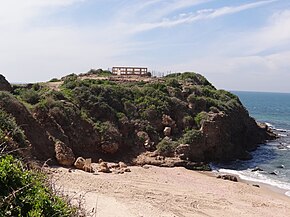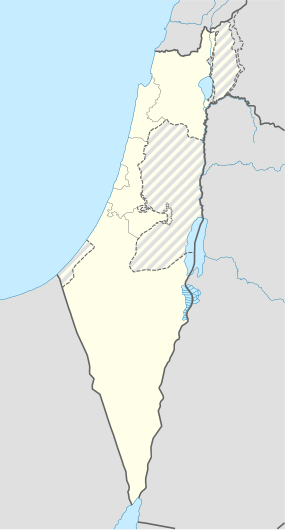Yavne-Yam
| יבנה-ים (Hebrew), Minet Rubin (Arabic) | |
 |
|
| Location | Mediterranean shore, near Palmachim |
|---|---|
| Region | Gan Raveh Regional Council |
| Coordinates | 31°55′22″N 34°41′40″E / 31.922878°N 34.694327°E |
| Type | Tell |
| Part of | Settlement |
| History | |
| Material | Stone |
| Abandoned | 12th century |
| Periods | Middle Bronze Age to Early Islamic Period |
| Site notes | |
| Excavation dates | 1967-1969 1992-present |
| Archaeologists | Jacob Kaplan Moshe Fischer |
| Condition | ruins |
| Public access | Yes |
Yavne-Yam (Hebrew: יבנה ים, also spelled Yavneh-Yam, literally Yavne-Sea) or Minet Rubin (Arabic, literally Port of Rubin, referring to biblical Reuben) is an archaeological site located on Israel's southern Mediterranean coast, about 15 km south of Tel Aviv. Built on eolianite hills next to a small promontory forming the sole anchorage able to provide shelter to seagoing vessels between Jaffa and the Sinai, Yavne-Yam is notable for its role as the port of ancient Yavne. Excavations carried out by Tel Aviv University since 1992 have revealed continuous habitation from the second millennium BCE up to the Middle Ages.
Surveys and excavations undertaken at Yavne-Yam during the 1950s and 1960s have revealed the existence of a large fortified site, consisting of a square enclosure with freestanding ramparts and marked by fortified gates, dating from the Middle and Late Bronze Age, during the second millennium BCE. This has also been confirmed by underwater surveys undertaken in the harbor, which have uncovered pottery characteristic of the period. Yavne-Yam may be the coastal city of Muḫḫazu (mHz) mentioned in the Amarna letters, a name reminiscent of the Aramaic word for port. It was inhabited during the late Iron Age, as testified by the Egyptian pottery and scarabs found at the site, as well as the discovery of Eastern Greek Pottery and several Hebrew-inscribed ostraca in nearby Mesad Hashavyahu. During the late 7th century BCE, the region apparently passed from Egyptian to Judean control, and was populated by Israelites, Canaanites, Phoenicians and perhaps even Greeks.
...
Wikipedia

